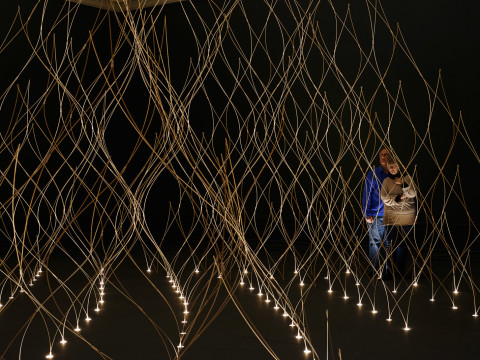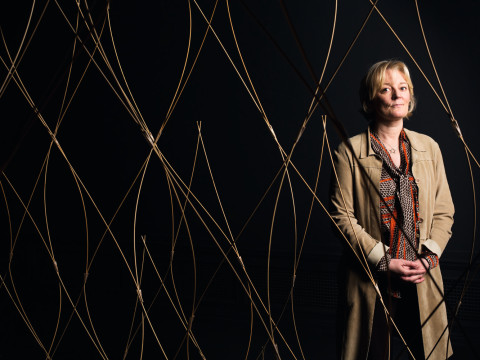
How do you make an architecture exhibition?
By Owen Hopkins
Published on 11 February 2014
This is a question that has vexed countless curators over the decades. For an exhibition of art, it’s seemingly obvious. But what does this mean when you're presenting the work of an architect?
Curators of art arguably have an easier time. An artist’s finished works – be they paintings, sculptures, photography, installation or video – take pride of place. There might be preparatory drawings, sketches or studies if we’re thinking about an Old Master exhibition, for instance, but almost without exception, the focus for the visitor – as it is for the curator – is the finished the work, the real thing, the very apogee of an artist’s practice. But with architecture, you have a few problems. An architect’s finished work, the thing by which they are judged as an architect – and I’m talking, of course, about an actual building – is almost always absent. It has been a convention, therefore, for architecture exhibitions to concentrate on an architect’s working methods and reveal the ‘design evolution’ of a particular building through drawings and models. The buildings themselves are illustrated through photographs and, latterly, CAD renderings (computer-generated images of the building as it might appear in real life).

There are ways one can get around the absence of the finished article, for example, by mounting an exhibition of an architect’s work in one of their buildings. This was done most spectacularly with the Palladio 500 exhibition in 2008, which was shown in Vicenza in Palladio’s Palazzo Barbaran da Porto and in London in early 2009 (as Andrea Palladio: His Life and Legacy), at the Royal Academy, whose home, Burlington House, is one of the earliest examples of eighteenth-century English Palladianism. This solution is, of course, not always possible and very rarely in the ways managed for the Palladio exhibition. Nonetheless, despite this apparently almost existential constraint for architecture exhibitions, some have helped to redefine the discipline at particular historic junctures and have helped shape its future direction.

Arguably the first of these was the Modern Architecture: International Exhibition that took place at New York’s Museum of Modern Art (MoMA) in 1932 before later touring across the US. Organised by the historian, Henry-Russell Hitchcock and architect Philip Johnson the exhibition thrust Modernism onto the global stage. Including work by figures such as Le Corbusier, Mies van der Rohe, J.J.P. Oud and Walter Gropius alongside the Americans, Frank Lloyd Wright and Richard Neutra, Johnson claimed their work as a new ‘International Style’, which was ‘probably the first fundamentally original and widely distributed style since the Gothic’. ‘Today’, he claimed, ‘the style has passed beyond the experimental stage. In almost every civilised country in the world it is reaching its full stride’. While Johnson’s claims were rather bombastic, the exhibition not only served to unify and codify a particular expression of Modernism, but gave it the wide exposure and institutional backing that helped establish it as a truly ‘International Style’.
Over five decades later, another exhibition at MoMa proved similarly influential by bringing to the fore a number of architects who had then built little but whose names are now very familiar. Featuring the work of Frank Gehry Hon RA, Zaha Hadid RA, Rem Koolhaas, Coop Himmelb(l)au, Peter Eisenman, Daniel Libeskind Hon RA and Bernard Tschumi, 1988’s Deconstructivist Architecture was again curated by Philip Johnson, this time with Mark Wigley. The rather ungainly title derived from an assimilation of Russian Constructivism and Deconstruction. The latter was the particular brand of Post-Structuralist linguistics associated with the French philosopher, Jacques Derrida, that in architecture was seen to be manifested in fragmented forms, bricolage and complex relationships to context and site. The link to Constructivism, meanwhile, alluded to the influence the abstract, geometrical languages formulated in Russia during the 1920s exerted on Hadid and Koolhaas especially. It was also fitting in a further way, because many Deconstructivist projects were, similarly to their Russian forebears, often confined to paper; given her subsequent success, it is hard to believe now that Hadid’s first building only came in 1994. Although its subjects were quick to evade the categorisation the exhibition’s title had made for them, the exhibition was remarkable in bringing together a group of architects who, almost without exception, have been at the forefront of world architecture for the last twenty years.
Not to be out done, the Royal Academy has had its own share of important architecture exhibitions. The most notable was New Architecture: Foster, Rogers, Stirling, put on in the Main Galleries in 1986. It took place just at the moment when its three protagonists were cementing their positions on the world stage, helping to establish the global reputation of British architecture. Even the cover of the exhibition’s catalogue, which depicted Norman Foster’s HSBC building in Hong Kong, Richard Rogers’ Lloyd’s Building and James Stirling’s Neue Staatsgalerie, Stuttgart, was illustrative of both the scale and significance of these architects’ work and its global reach. As well as showcasing recent work, the exhibition also offered each architect a platform for new ideas and provocations. The most famous was Rogers’ ‘London as it could be’, a huge model for reimagining the centre of London, reintegrating the city with the Thames and engineering the primacy of the pedestrian over the car. Real water was used for the Thames in Rogers’ model, and a story goes that at the exhibition opening Stirling smuggled in a live goldfish, which he added to the flowing model river! Given that today the Thames is as clean as it’s been for decades with fish returning, partly as a consequence of the regeneration that Rogers and others have advocated, Stirling’s playful act was unintentionally rather prescient.
Part of ‘London as it could be’ was exhibited as part of the recent exhibition, Richard Rogers RA: Inside Out, which ran at the RA over summer 2013. That exhibition focused on Rogers’ influential ideas on architecture and cities, arguing, perhaps above for all, for architecture as something that is absolutely fundamental to how we live. It is this idea, though quite differently manifested, that links directly with Sensing Spaces: Architecture Reimagined. This exhibition argues that the direct experience of the buildings and spaces around us is central to our understanding of architecture. It is a welcome antidote to the global prevalence and proliferation of the weirdly-shaped ‘iconic’ building, and helps get us back to the real essence of architecture. It is hard to predict the influence, if any, an exhibition will have, but Sensing Spaces might just be an exhibition that’s looked back on at least as something that was bold and a bit a different, breaking new ground and going against the grain.
Owen Hopkins is Acting Manager of the RA's Architecture Programme.
Related articles

Revisiting the exhibition: Sensing Spaces
10 June 2020

Grand masters: Hawksmoor vs Wren
11 November 2015

Architecture and Freedom: a changing connection
2 September 2015

Seeing scents
3 March 2014

Meet the architects: Álvaro Siza and Eduardo Souto de Moura
19 January 2014

Meet the architects: Kengo Kuma
16 January 2014


